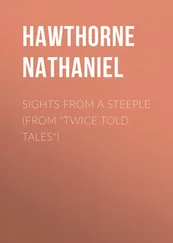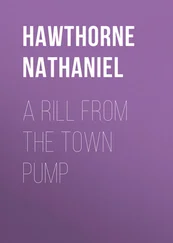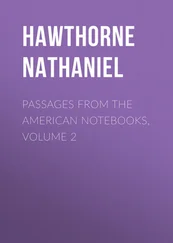Nathaniel Hawthorne - Passages from the French and Italian Notebooks, Volume 2
Здесь есть возможность читать онлайн «Nathaniel Hawthorne - Passages from the French and Italian Notebooks, Volume 2» — ознакомительный отрывок электронной книги совершенно бесплатно, а после прочтения отрывка купить полную версию. В некоторых случаях можно слушать аудио, скачать через торрент в формате fb2 и присутствует краткое содержание. Жанр: literature_19, foreign_antique, foreign_prose, на английском языке. Описание произведения, (предисловие) а так же отзывы посетителей доступны на портале библиотеки ЛибКат.
- Название:Passages from the French and Italian Notebooks, Volume 2
- Автор:
- Жанр:
- Год:неизвестен
- ISBN:нет данных
- Рейтинг книги:3 / 5. Голосов: 1
-
Избранное:Добавить в избранное
- Отзывы:
-
Ваша оценка:
- 60
- 1
- 2
- 3
- 4
- 5
Passages from the French and Italian Notebooks, Volume 2: краткое содержание, описание и аннотация
Предлагаем к чтению аннотацию, описание, краткое содержание или предисловие (зависит от того, что написал сам автор книги «Passages from the French and Italian Notebooks, Volume 2»). Если вы не нашли необходимую информацию о книге — напишите в комментариях, мы постараемся отыскать её.
Passages from the French and Italian Notebooks, Volume 2 — читать онлайн ознакомительный отрывок
Ниже представлен текст книги, разбитый по страницам. Система сохранения места последней прочитанной страницы, позволяет с удобством читать онлайн бесплатно книгу «Passages from the French and Italian Notebooks, Volume 2», без необходимости каждый раз заново искать на чём Вы остановились. Поставьте закладку, и сможете в любой момент перейти на страницу, на которой закончили чтение.
Интервал:
Закладка:
His talk soon turned upon sculpture, and he spoke once more of the difficulty imposed upon an artist by the necessity of clothing portrait statues in the modern costume. I find that he does not approve either of nudity or of the Roman toga for a modern statue; neither does he think it right to shirk the difficulty – as Chantrey did in the case of Washington – by enveloping him in a cloak; but acknowledges the propriety of taking the actual costume of the age and doing his best with it. He himself did so with his own Washington, and also with a statue that he made of Daniel Webster. I suggested that though this costume might not appear ridiculous to us now, yet, two or three centuries hence, it would create, to the people of that day, an impossibility of seeing the real man through the absurdity of his envelopment, after it shall have entirely grown out of fashion and remembrance; and Webster would seem as absurd to them then as he would to us now in the masquerade of some bygone day. It might be well, therefore, to adopt some conventional costume, never actual, but always graceful and noble. Besides, Webster, for example, had other costumes than that which he wore in public, and perhaps it was in those that he lived his most real life; his dressing-gown, his drapery of the night, the dress that he wore on his fishing-excursions; in these other costumes he spent three fourths of his time, and most probably was thus arrayed when he conceived the great thoughts that afterwards, in some formal and outside mood, he gave forth to the public. I scarcely think I was right, but am not sure of the contrary. At any rate, I know that I should have felt much more sure that I knew the real Webster, if I had seen him in any of the above-mentioned dresses, than either in his swallow-tailed coat or frock.
Talking of a taste for painting and sculpture, Powers observed that it was something very different and quite apart from the moral sense, and that it was often, perhaps generally, possessed by unprincipled men of ability and cultivation. I have had this perception myself. A genuine love of painting and sculpture, and perhaps of music, seems often to have distinguished men capable of every social crime, and to have formed a fine and hard enamel over their characters. Perhaps it is because such tastes are artificial, the product of cultivation, and, when highly developed, imply a great remove from natural simplicity.
This morning I went with U – to the Uffizi gallery, and again looked with more or less attention at almost every picture and statue. I saw a little picture of the golden age, by Zucchero, in which the charms of youths and virgins are depicted with a freedom that this iron age can hardly bear to look at. The cabinet of gems happened to be open for the admission of a privileged party, and we likewise went in and saw a brilliant collection of goldsmiths' work, among which, no doubt, were specimens from such hands as Benvenuto Cellini. Little busts with diamond eyes; boxes of gems; cups carved out of precious material; crystal vases, beautifully chased and engraved, and sparkling with jewels; great pearls, in the midst of rubies; opals, rich with all manner of lovely lights. I remember Benvenuto Cellini, in his memoirs, speaks of manufacturing such playthings as these.
I observed another characteristic of the summer streets of Florence to-day; tables, movable to and fro, on wheels, and set out with cool iced drinks and cordials.
June 17th. – My wife and I went, this morning, to the Academy of Fine Arts, and, on our way thither, went into the Duomo, where we found a deliciously cool twilight, through which shone the mild gleam of the painted windows. I cannot but think it a pity that St. Peter's is not lighted by such windows as these, although I by no means saw the glory in them now that I have spoken of in a record of my former visit. We found out the monument of Giotto, a tablet, and portrait in bas-relief, on the wall, near the entrance of the cathedral, on the right hand; also a representation, in fresco, of a knight on horseback, the memorial of one John Rawkwood, close by the door, to the left. The priests were chanting a service of some kind or other in the choir, terribly inharmonious, and out of tune..
On reaching the Academy, the soldier or policeman at the entrance directed us into the large hall, the walls of which were covered on both sides with pictures, arranged as nearly as possible in a progressive series, with reference to the date of the painters; so that here the origin and procession of the art may be traced through the course of, at least, two hundred years. Giotto, Cimabue, and others of unfamiliar names to me, are among the earliest; and, except as curiosities, I should never desire to look once at them, nor think of looking twice. They seem to have been executed with great care and conscientiousness, and the heads are often wrought out with minuteness and fidelity, and have so much expression that they tell their own story clearly enough; but it seems not to have been the painter's aim to effect a lifelike illusion, the background and accessories being conventional. The trees are no more like real trees than the feather of a pen, and there is no perspective, the figure of the picture being shadowed forth on a surface of burnished gold. The effect, when these pictures, some of them very large, were new and freshly gilded, must have been exceedingly brilliant, and much resembling, on an immensely larger scale, the rich illuminations in an old monkish missal. In fact, we have not now, in pictorial ornament, anything at all comparable to what their splendor must have been. I was most struck with a picture, by Fabriana Gentile, of the Adoration of the Magi, where the faces and figures have a great deal of life and action, and even grace, and where the jewelled crowns, the rich embroidered robes, and cloth of gold, and all the magnificence of the three kings, are represented with the vividness of the real thing: a gold sword-hilt, for instance, or a pair of gold spurs, being actually embossed on the picture. The effect is very powerful, and though produced in what modern painters would pronounce an unjustifiable way, there is yet pictorial art enough to reconcile it to the spectator's mind. Certainly, the people of the Middle Ages knew better than ourselves what is magnificence, and how to produce it; and what a glorious work must that have been, both in its mere sheen of burnished gold, and in its illuminating art, which shines thus through the gloom of perhaps four centuries.
Fra Angelico is a man much admired by those who have a taste for Pre-Raphaelite painters; and, though I take little or no pleasure in his works, I can see that there is great delicacy of execution in his heads, and that generally he produces such a Christ, and such a Virgin, and such saints, as he could not have foreseen, except in a pure and holy imagination, nor have wrought out without saying a prayer between every two touches of his brush. I might come to like him, in time, if I thought it worth while; but it is enough to have an outside perception of his kind and degree of merit, and so to let him pass into the garret of oblivion, where many things as good, or better, are piled away, that our own age may not stumble over them. Perugino is the first painter whose works seem really worth preserving for the genuine merit that is in them, apart from any quaintness and curiosity of an ancient and new-born art. Probably his religion was more genuine than Raphael's, and therefore the Virgin often revealed herself to him in a loftier and sweeter face of divine womanhood than all the genius of Raphael could produce. There is a Crucifixion by him in this gallery, which made me partly feel as if I were a far-off spectator, – no, I did not mean a Crucifixion, but a picture of Christ dead, lying, with a calm, sweet face, on his mother's knees ["a Pieta"].
Читать дальшеИнтервал:
Закладка:
Похожие книги на «Passages from the French and Italian Notebooks, Volume 2»
Представляем Вашему вниманию похожие книги на «Passages from the French and Italian Notebooks, Volume 2» списком для выбора. Мы отобрали схожую по названию и смыслу литературу в надежде предоставить читателям больше вариантов отыскать новые, интересные, ещё непрочитанные произведения.
Обсуждение, отзывы о книге «Passages from the French and Italian Notebooks, Volume 2» и просто собственные мнения читателей. Оставьте ваши комментарии, напишите, что Вы думаете о произведении, его смысле или главных героях. Укажите что конкретно понравилось, а что нет, и почему Вы так считаете.












